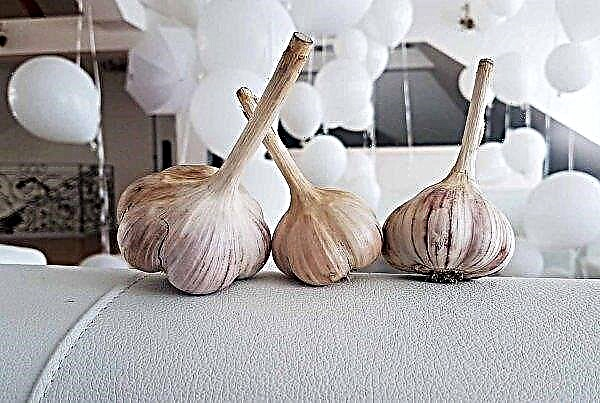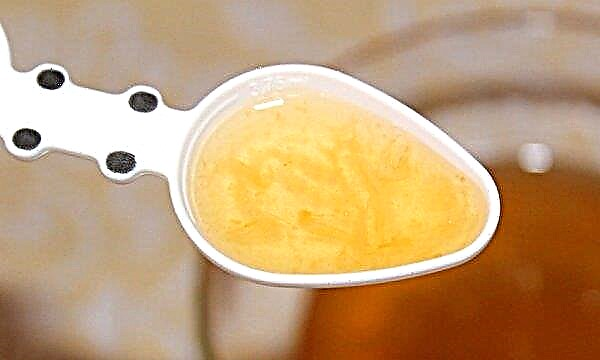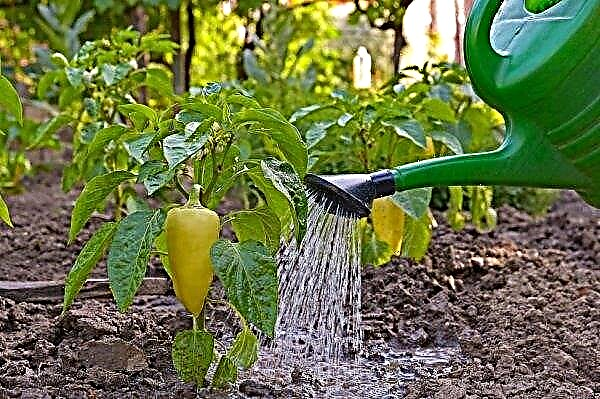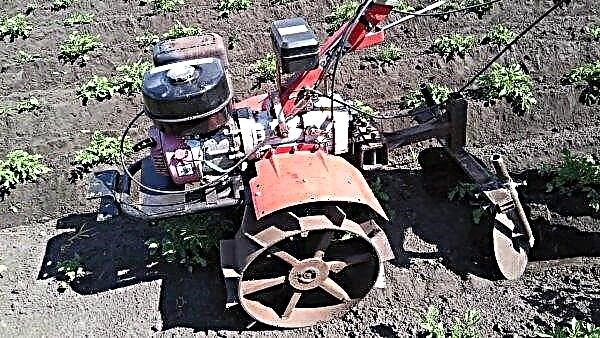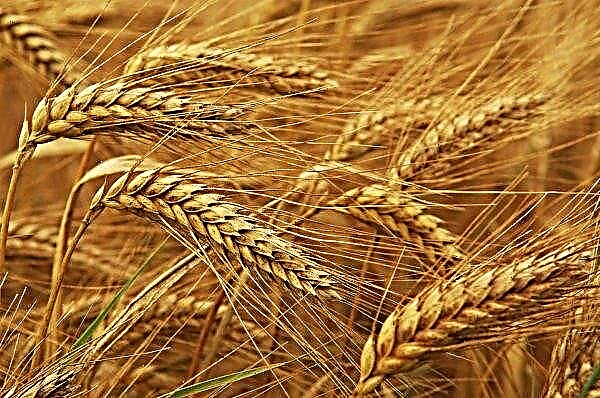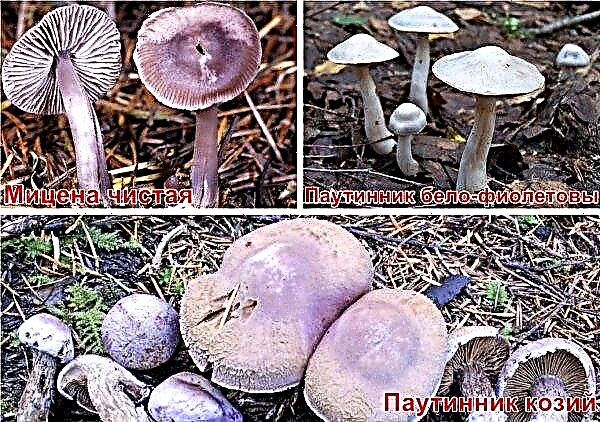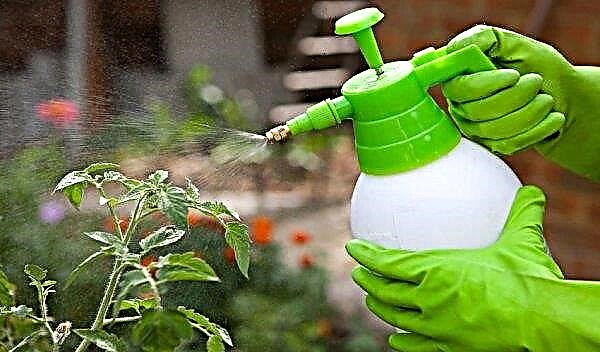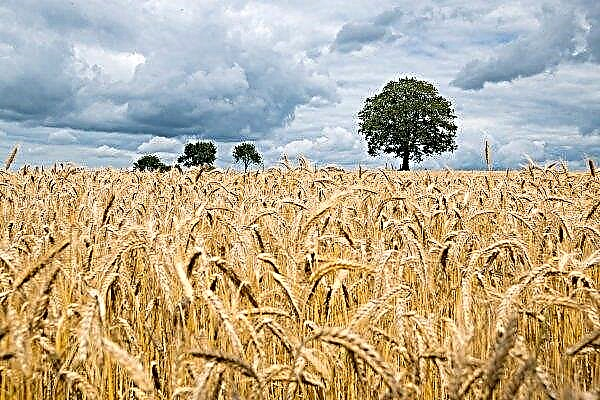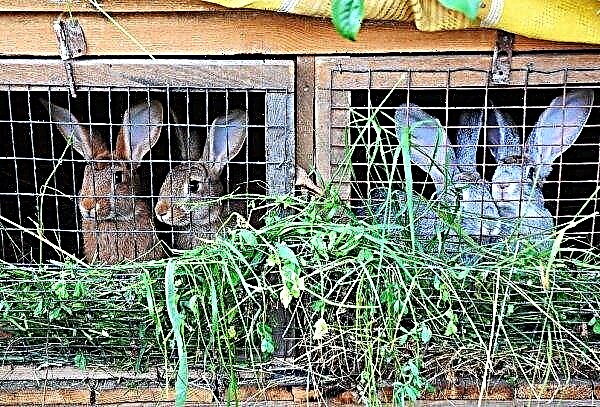Thuja Hoseri (western) is one of the most sought after plants that gardeners decorate their plots. For a description of the characteristics of the culture, as well as how to care for it, read on.
Grade description
Thuja Khoseri - coniferous shrub, which as it grows can reach from 80 to 100 cm in height. The diameter of its crown is up to 100 cm. In the first years of growth, the shape of the apex resembles a ball, but as it develops, it can change to ovoid. The trunk is brown, thin, has several branches.
 The needles are scaly, dark green, with a shade of gray, in the autumn period changes to bronze color.
The needles are scaly, dark green, with a shade of gray, in the autumn period changes to bronze color.
Use in landscape design
Using thuja in landscape design, you can easily transform not only the garden view, but also ennoble a relaxation area in a park or park. Planting on the site of this plant is a trend of the Western style that came to the CIS countries from North America about two hundred years ago.
Many gardeners prefer this variety because of its unpretentiousness in cultivation and care. This plant is also used in the landscape because of its luxurious crown, which is easy to turn into an interesting figure.
Important! Thuja is an excellent means of noise isolation in an empty yard, and also takes on the blow of dusty masses carried by the wind. The plant also fills the air with a pleasant aroma that can neutralize pathogens.
Single landing
The Khosery variety is great even for single plantings. With the help of proper pruning, the plant can be given any shape, thereby beating it advantageously against the background of other plants. Single landings are used to emphasize, for example, such flower beds can be found at the entrance to the building or at the fountains. The thuja looks very successful in the composition with flowers, which will be described below.

Live borders
Ornamental plant is often used as a hedge. Such planting will allow the gardener to observe fresh green plants all year round. Planting in the form of hedges can also be used to strengthen the slopes. This type of planting not only looks aesthetically pleasing, but is safer, for example, than a Christmas tree that has prickly needles.

Songs
Thuja looks great in compositions, it is combined with various flowers and shrubs.
- The most beneficial can be called such combinations with the Khosery variety:
- barberry;
- hybrid wigel;
- spirea;
- rose bushes of any color;
- decorative spruce and fir.

Compositions on flower beds can be of any variations and color schemes, each gardener can combine the arrangement of plants at his discretion. The main thing is that they do not interfere with each other's development.
 1. Thuja western Smaragd (Smaragd); 2. Panicled Hydrangea Vanille Fraise (Vanilla Frize); 3. Thuja western Hoseri (Khoseri); 4. 4. Juniper Nana (Nana).
1. Thuja western Smaragd (Smaragd); 2. Panicled Hydrangea Vanille Fraise (Vanilla Frize); 3. Thuja western Hoseri (Khoseri); 4. 4. Juniper Nana (Nana).
In pots
Thuja Khoseri is an excellent option for propagation and cultivation in pots. An evergreen will be the best decoration on any balcony or terrace. The advantage of its cultivation in pots is its high frost resistance, which will allow the plant to be kept on the balcony all year round even at relatively low temperatures.
 This variety fits perfectly into any interior and is combined with other indoor colors.
This variety fits perfectly into any interior and is combined with other indoor colors.
Landing
The main condition for good survival of the seedlings will be the correctly selected planting time. It is necessary to plant thuja in open ground in spring, at the end of April, or in autumn, from mid-September to mid-October. The climatic features of the region should also be taken into account. So, for example, in the northern regions, it is better to plant plants in the spring so that the root system has time to grow stronger by the winter period.
Growth requirements
In order for the thuja to develop well, it is better to plant it in an area with good lighting or partial shade. The choice of soil composition is not fundamental. This crop grows well in both fertile and sandy soils with a slightly acidic pH.  For cultivating the Khosery variety, it is better to avoid plots with lowlands and the risk of flooding in order to avoid rotting of the rhizome.
For cultivating the Khosery variety, it is better to avoid plots with lowlands and the risk of flooding in order to avoid rotting of the rhizome.
Step-by-step instruction
In order to plant a thuja seedling, you need to dig a hole 50 cm deep and 70 cm wide.
It is also necessary to prepare a substrate for filling the wells by mixing such components (in the proportions of 2: 1: 1, respectively):
- fertile soil;
- sand;
- peat.
Important! If you plant a thuja in the shade, it will develop poorly and lose its visual appeal due to the fading of color.
Step-by-step instructions for landing:
- At the bottom of the dug pit, pour a drainage base of expanded clay or sand to a height of 3-4 cm.
- Pour a substrate of earth, sand and peat to the middle of the hole and form it in the shape of a knoll.
- Insert the seedling into the pit so that the root of the neck is 1-2 cm above the hole.
- Fill the pit with the substrate to the top and gently tamp.
- Water the plant with 5 liters of water.

Care
Timely care of the plant will save the gardener from problems with diseases and pests.
This variety requires the following care procedures:
- watering;
- top dressing;
- mulching;
- pruning
- in the northern regions - shelter for the winter.
If you do not neglect the above procedures, the plant will delight the eye with beautiful needles all year round.
Watering and feeding
Thuja sapling needs constant irrigation until new branches grow on it, so watering should be carried out during the first 2 months as the earthen coma dries. Further irrigation is carried out at the rate of 8 liters per shrub every 7-10 days.
 In order for the crown to maintain its beautiful appearance, sprinkling can be carried out every week.
In order for the crown to maintain its beautiful appearance, sprinkling can be carried out every week.
To make the coniferous plant beautiful and healthy throughout the entire warm period, fertilizing with Zircon is carried out with an interval of 10-14 days. To prepare the solution, take 1 ampoule of the drug in 10 liters of water. When processing, it is necessary to moisten each plant profusely.
This solution is also effective not only to preserve the beauty of the crown, but also used as a root top dressing. It stimulates the growth of roots, and is also effective in combating many strains of the fungus.
 The use of the Zircon preparation for watering implies the same dosage as for irrigation of the crown (1 ampoule per 10 liters of water). The prepared solution is used at the rate of 10 liters per 1 m².
The use of the Zircon preparation for watering implies the same dosage as for irrigation of the crown (1 ampoule per 10 liters of water). The prepared solution is used at the rate of 10 liters per 1 m².
Pruning
In order to carry out the pruning procedure, you will need well-sharpened garden tools: a pruning shears, scissors with elongated blades, as well as a pair of gloves to protect your hands. Thuja Khosery is a decorative variety, therefore, it does not need forming pruning, except in those cases when the gardener wants to cut out a certain figure from the bush.
Every year in the spring, the plant needs sanitary pruning, which consists in removing dried, diseased or insect-damaged branches.Did you know? The needles and branches of thuja are rich in ascorbic acid, therefore, in the Middle Ages, sailors used them to fight scurvy..
Video: Thuja Khozeri's topiary haircut
Mulching and preparing for winter
In the autumn, the plant needs to be prepared for the upcoming cold weather. After watering, the soil near the bush is mulched with peat to a depth of 5–7 cm. This procedure will allow for a long time to keep moisture and heat in the root system.
The area near the plants is cleaned of fallen leaves and other debris, all faded flowers that were planted nearby for the composition are removed. Thuja Khosery is frost-resistant and does not need shelter for the winter. But if cultivation is carried out in the northern regions with a decrease in temperature lower than -30 ° C, it is better to cover the plants with burlap or dig in the snow.
Disease and Pest Prevention
Conifers have a stable immunity to diseases and pests.
But with improper care and bad weather conditions, the plant can be affected by a number of fungal infections, for example, such as:
- Cytospore necrosis - manifests itself in the form of a change in the color of needles from green to brown. On the trunk of the affected shrub, tubercles with prominent golden drops can be seen.

- Diplodiosis - it strikes the needles, it acquires a reddish tint, and small black bumps form on the places of dead particles on the trunk and branches.

- Brown shute - is a disease that develops in the winter. On the parts of the crown under the snow, a brown coating of mold forms, which sticks together the needles and leads to its death, leaving scraps on the bush.

Among insects, the most dangerous for thuja are aphids and scale insects, which suck out the juice from needles and cones, which leads to a slowdown of the plant and significantly affect its appearance.
- To avoid the invasion of pests and prevent fungal diseases, a number of preventive measures should be taken:
- clean the area from fallen leaves and vegetation residues;
- conduct annual sanitary pruning of shrubs;
- loosen the soil near the trunk after each watering;
- apply dressing strictly according to the instructions;
- in the spring, spray the shrub with a 1% copper solution (100 g per 10 l of water).
Did you know? In 2002, a group of German biologists came to the discovery that a mixture of water, alcohol and thuja extract was able to withstand type A influenza virus.
Thuja Khozeri is excellent for growing with the aim of improving the area near the house. Many gardeners choose this plant because it is unpretentious in care and requires virtually no pruning.




